But what if your hot water is not so freely to be had? If it doesn’t come
at the turn of a faucet? Where cold is the natural -- hot a rare treat, whether
temporary or every day. Or what if you want to
heat your water less expensively - economically or environmentally? Then look
to the sky, your lifestyle, and your own ingenuity for your answers, and your
hot water.
Whether your water comes from a spring, the rain, a well, or the water
treatment plant, you can heat it without burning additional fuel. And once the
routine has become habit, it can be as natural as turning the tap, and not a
whole lot more trouble.
Having lived quite comfortably and happily without running hot water for
twenty-five years, I’m usually at a loss when pressed to explain why it is not
a problem. I’m not into martyrdom or suffering, managing our water is simply a
part of our life, and not a very difficult one at that. (Not counting the
occasional middle of winter pump or windmill problems.) If instant hot showers
are important to you, you’ll figure out a way to have them, running hot water
or not. But if you can get over that "need", your life will be a lot
easier. Then the occasional hot shower will be a treat that can never be so
appreciated by the "have it every day" crowd.
Hot showers aside, there are many other reasons for having a good source of
hot water. Your lifestyle and place of dwelling will dictate your options for
heating water. But even if you don’t live in the cold north, hopefully the
following will give you some ideas and inspiration to create your own unique hot
water system. Ours isn’t a one track route. As with most of our living, how we
heat and use water depends on the season, the weather, and the pattern of our
lives at that time.
WINTER WATER HEATING
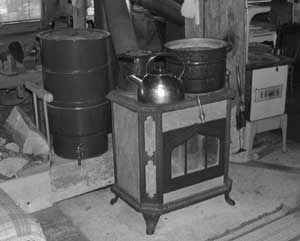 THE WOOD STOVE: If you heat, or cook, with wood, then you are no doubt quite
familiar with this basic hot water heater -- a kettle on the stove. If you are
shopping for a wood heating stove, consider one with the most flat and usable
top surface. Ours is always crowded when the fire is going. A large tea kettle
for drinks and cooking and a well used enameled coffee pot for dish and people
washing are the usual residents. When more hot water is needed for laundry, then
room is made for an old chipped but still intact enameled canning kettle. We are
never short of hot water in the winter.
THE WOOD STOVE: If you heat, or cook, with wood, then you are no doubt quite
familiar with this basic hot water heater -- a kettle on the stove. If you are
shopping for a wood heating stove, consider one with the most flat and usable
top surface. Ours is always crowded when the fire is going. A large tea kettle
for drinks and cooking and a well used enameled coffee pot for dish and people
washing are the usual residents. When more hot water is needed for laundry, then
room is made for an old chipped but still intact enameled canning kettle. We are
never short of hot water in the winter.
Used pots and kettles for heating water are easily found. Since they heat
only water, most any metal will do. Glass or pottery containers can work fine,
if they are made for that purpose. Even if you don’t heat with wood, explore
ways to use your heating source to heat some water as well, without using
additional fuel.
WATER TANK: A plumber friend found us a small, glass lined, steel
bladder-type water tank with burned out elements. Steve discarded (recycled) the
thin metal outer jacket, then cut a large hole in the top of the inner tank
(removing the bladder). A faucet was installed in the bottom. I painted all the
steel areas a dark color to keep it from rusting and to better absorb heat. Then
we set it up near the wood stove. Kept full of water, this provides a steady
supply of warm water when the stove is going and for quite a long time after the
fire has gone out. Since is isn’t insulated, it also acts as a heat storage
medium, supplying gentle heat for the house as well.
This idea can also be used in an expanded way with a conventional furnace and
water heater. My brother-in-law set up an extra, full sized water heater next to
his furnace. Cold water is piped to this tank first where it is naturally
pre-heated, then on to the regular water heater.
You can also get, or make, heating coils to go in your wood stoves. Though we’ve
considered them in the past, using kettles on top of the stove is so easy and
works so well we’ve never thought it worth the trouble to install inner coils.
Especially considering our hard water which limes up everything it touches in
short order. It’s pretty easy to shake the sheets of lime deposits out of the
kettles every once in a while.
SPRING and FALL: This is our hardest time for hot water heating. The wood
heating stove is not going all the time, yet there is not enough sun for good
outdoor heating. The heat holding capacity of a large kettle of water comes in
handy here. When either the heating or cook stove is going, water is heating. It
keeps its warmth for a surprisingly long time. Washing chores are more apt to
revolve around wood stove use, when the water is hot. And cookstove use is more
likely to revolve around hot water needs. It is a balance that works itself out
quite naturally, once the idea is in the mind.
And among all the systems can be found a constant companion . . .
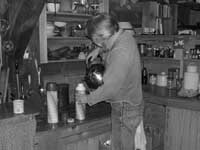 THERMOSES: Plain, everyday, glass lined metal thermos bottles. We
make use of these year-round, using more or fewer as the season dictates. Next
to the kettles and heat sources, this is the most important part of our water
heating system. Whenever there is hot water, no matter how it was heated, the
thermoses are filled. It is a habit that gets little thought. Instant hot water
at your fingertips. No need to heat an entire kettle full of water for one cup
of tea. Get the water from the thermos. And when the thermos is empty? Then heat
up that kettle of water, but pour what is left in the thermos for the next cup,
or for the pasta pot, or to wash dishes, or whatever.
THERMOSES: Plain, everyday, glass lined metal thermos bottles. We
make use of these year-round, using more or fewer as the season dictates. Next
to the kettles and heat sources, this is the most important part of our water
heating system. Whenever there is hot water, no matter how it was heated, the
thermoses are filled. It is a habit that gets little thought. Instant hot water
at your fingertips. No need to heat an entire kettle full of water for one cup
of tea. Get the water from the thermos. And when the thermos is empty? Then heat
up that kettle of water, but pour what is left in the thermos for the next cup,
or for the pasta pot, or to wash dishes, or whatever.
When hot water is scarce, as when any water is scarce, one naturally finds
ways to use it wisely and conservatively. When you discover how little water,
hot or cold, is really needed for more than adequate washing and cooking and
cleaning and living, you will wonder how the habit of gushing gallons of water
over and around and down the drain ever came to be. Again, no martyrdom or
suffering here, just natural conservative (with its root word, conserve) use of
hot water.
SPRING and SUMMER: Now the ease of a kettle on the heating stove is over
(usually), but the hot water options expand. For those in non-freezing areas,
these are ideas that may be able to be used year-round.
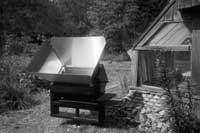 SOLAR OVEN: When the sun gets high enough in the sky, the patterns change and
our focus moves more outside than in. The solar oven comes out of storage, the
reflectors installed, and before the hour is up (assuming the sun is shining!)
dinner is cooking and the water pot is heating. From here on until the short
days of fall descend upon us, there is water heating in the solar oven whenever
the sun is shining. Because space is limited (and the water heating has to share
with the food cooking), we make use of a smaller glass coffee pot (innards
removed) and a quart jar with a hole punched in the metal lid. Another thermos
is hauled out from the back of a cupboard, and the heating of water and filling
of thermoses ritual is soon a regular part of life. Easy, free, hot water.
[Here is a link to more information on our solar oven
LINK.]
SOLAR OVEN: When the sun gets high enough in the sky, the patterns change and
our focus moves more outside than in. The solar oven comes out of storage, the
reflectors installed, and before the hour is up (assuming the sun is shining!)
dinner is cooking and the water pot is heating. From here on until the short
days of fall descend upon us, there is water heating in the solar oven whenever
the sun is shining. Because space is limited (and the water heating has to share
with the food cooking), we make use of a smaller glass coffee pot (innards
removed) and a quart jar with a hole punched in the metal lid. Another thermos
is hauled out from the back of a cupboard, and the heating of water and filling
of thermoses ritual is soon a regular part of life. Easy, free, hot water.
[Here is a link to more information on our solar oven
LINK.]
Unfortunately, because our house is located in a small clearing in the woods,
we lose the direct sun rays fairly early. And with the long summer days, we are
usually working and playing outside until quite late. So to keep whatever is in
the solar oven hot longer, when the sun goes behind the trees, I lay a folded
quilt or blanket on the glass of the oven. Easy and works great.
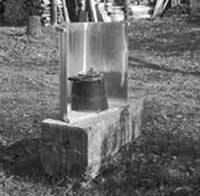 BLACK KETTLE: Heating water in the solar oven is fine for drinking and cooking
needs, and minimal washing. But it is usually not quite enough. So we make use
of the old dark enameled coffee pot, and the natural heating effect of the sun
on dark material. For years we simply set the kettle on a bench in the sun.
Which does a surprisingly good job, and is easy to do wherever you are. But if
there is a breeze, or the weather is cool, the kettle cools off faster than you
would like. We knew a reflector would concentrate more of the sun’s rays on
the kettle, thereby doing a better job of heating. So we propped a scrap of
corrugated metal roofing behind the kettle, which helped, but with any wind it
was more often on the ground than not. So finally Steve took the time to make a
simple reflector of a more permanent (and useful) design. Simple, but functional. And,
important to me, easy to use with no fuss.
BLACK KETTLE: Heating water in the solar oven is fine for drinking and cooking
needs, and minimal washing. But it is usually not quite enough. So we make use
of the old dark enameled coffee pot, and the natural heating effect of the sun
on dark material. For years we simply set the kettle on a bench in the sun.
Which does a surprisingly good job, and is easy to do wherever you are. But if
there is a breeze, or the weather is cool, the kettle cools off faster than you
would like. We knew a reflector would concentrate more of the sun’s rays on
the kettle, thereby doing a better job of heating. So we propped a scrap of
corrugated metal roofing behind the kettle, which helped, but with any wind it
was more often on the ground than not. So finally Steve took the time to make a
simple reflector of a more permanent (and useful) design. Simple, but functional. And,
important to me, easy to use with no fuss.
This was made with scraps: a 19" 1 x 10 pine board for the base, a
31" long piece of 20" aluminum flashing for the reflector, and a
1" x 30" semi-circle cut from a scrap of 5/8" plywood for the top
brace. The rough pine board was planed and sanded, an arc drawn to fit the
piece, then sawn to shape. The half circle base was used as a template to
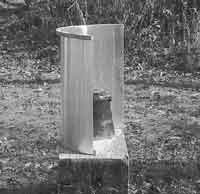 draw
the plywood top brace (the outer edge of the base being the inner edge of the
top brace). This was then bandsawn out and sanded smooth. The cut edges of the
aluminum flashing were bent back and pounded flat, for rigidity and safety. Then
the flashing reflector was nailed onto the pine base, and to the plywood top
brace. The wood was well oiled and the reflector unit done. Simple and
surprisingly sturdy.
draw
the plywood top brace (the outer edge of the base being the inner edge of the
top brace). This was then bandsawn out and sanded smooth. The cut edges of the
aluminum flashing were bent back and pounded flat, for rigidity and safety. Then
the flashing reflector was nailed onto the pine base, and to the plywood top
brace. The wood was well oiled and the reflector unit done. Simple and
surprisingly sturdy.
The black kettle is set on the base and the whole thing aimed toward the sun.
And before long, a kettle full of hot water is ready for use. If the sun goes
down before you’re ready for the water, throw an old blanket or quilt over it
to keep it warm. This works well no matter how the water has been heated.
In the summer, I use cold water for laundry so don’t worry about larger
amounts of hot water for that use. (In the winter, I warm the water for
myself--the clothes don’t really care). But should you want more hot water,
here are a couple of other ideas.
BLACK PIPE: One year we stretched 3/4 inch black water pipe across the
ground. Actually, across the roof of our house, since we have an easily
accessible sod roof, but any ground that has short vegetation and is in the sun
will do. One end was connected to an outside faucet on the house, the other was
fitted with a regular garden hose nozzle. This did a great job of heating water
very hot whenever the sun was shining. Trouble was, it cooled off pretty fast
when the sun went down, and we were never ready for the hot water when it was
ready. Of course, we wanted it to cool down some, as we planned to use it for
outdoor showers.
Well, the romance of standing outside, naked, in the spring or summer
evening, in the northwoods, showering away the day’s grime and sweat with a
nice stream of warm water is pretty short lived when one actually takes part in
such a ritual. Unless you are a bit of a masochist, and don’t mind being eaten
alive by mosquitoes and black flies. We both minded. During this time of year,
the sauna makes as much sense as in the middle of winter, just for different
reasons. Building a sauna is still high on our list of things to do. Maybe in
our second quarter century here we’ll get it done. Meantime, we wash within
the mosquitoless comfort of our home.
Of course, not everyone has that problem, and an outdoor shower can be great,
whether with bucket or hose, enclosure or not. And a Black Pipe Heater (if long
enough) does get a lot of water hot in a rather short time. You can also coil
the pipe loosely on a south facing sloped surface for a more compact heater.
A natural addition to the Black Pipe Water Heater would be a simple insulated
water tank to run the day’s hot water into, to be used when needed after the
sun has gone down. This wouldn’t be that difficult to come up with. We simply
found out we didn’t need that much hot water.
BULK HOT WATER HEATER: Another style bulk water heater can also be made
without a lot of cost. Although we haven’t done this (for the afore mentioned
reason), friends have and it works great for them. It is, in essence, a very
large solar oven, with the same requirements--an insulated box with an interior
reflective surface (aluminum foil, shiny metal, gloss white paint), a glass
front aimed at the sun, a metal water tank painted black, a water source going
in, and a way to tap the water out. Because of the volume, the water will stay
hot for quite a while. Or you can make use of an insulated cover when the sun
goes down.
In the sixties and seventies there was quite a lot of interest in basic and
simple alternative heating devices, and a number of designs were to be found in
books and articles. Check out libraries and used bookstores for information. You
can design your own out of materials you have or can get, and build it for very
little cost.
INSTANT WATER HEATER: This is something that is common in Europe, and I wish
it would become common here. If you desire a steady supply of hot water and have
conventional heating (propane or electric) look into the instant wall mounted
water heaters. Small and efficient, they make so much more sense than the usual
large volume hot water heaters. Proof that environmentally friendly solutions
don’t have to be difficult.
WASTEWATER: This is an aside, but certainly related. Where does the water you
use go? For many readers, running water, conventional sewer or septic tank, and
flush toilets are part of everyday life -- it is what your house has. But it
doesn’t mean you can't be conservative in your use, hopefully you already do.
Have you ever really looked at how much you use (other than that bill each
month!)? Make it a game, read your water meter every day, same time, and write it down. See how much you use.
Then one by one, take each area of your water usage, and reduce the amount you
use. Make those numbers go down, and down, and down. Put that money saved in a
fund to buy something that will help even more - a more efficient furnace? A low flush
toilet? A composting toilet? And enjoy the challenge. We did this when living in a conventional house
and were surprised at how much water we could comfortably live without, or how
little we could comfortably live with.
Particularly
nice if you can reduce that great amount of clean water that goes down the
toilet. Check out alternatives, including bucket flushing. Those who live with alternate water sources are
no doubt already well acquainted with the humble bucket tool. But this is
something anyone can use. Put a bucket near wherever you use water -- kitchen,
bathroom, utility room, mud room. Use plastic tubs or basins in your sinks. Pour
the fairly clean wastewater into the bucket instead of down the sink. Then use that water to
flush the toilet(s). A little more effort it is true, but it works.
Maybe the best way to appreciate fresh water or hot water is to go without
for a time. It does make one more aware. And
awareness often brings even more ideas, and a certain sparkle to
life that cannot be seen otherwise. I hope you enjoy the sparkle, whether your
water is hot or cold or comfortably lukewarm.



 THE WOOD STOVE: If you heat, or cook, with wood, then you are no doubt quite
familiar with this basic hot water heater -- a kettle on the stove. If you are
shopping for a wood heating stove, consider one with the most flat and usable
top surface. Ours is always crowded when the fire is going. A large tea kettle
for drinks and cooking and a well used enameled coffee pot for dish and people
washing are the usual residents. When more hot water is needed for laundry, then
room is made for an old chipped but still intact enameled canning kettle. We are
never short of hot water in the winter.
THE WOOD STOVE: If you heat, or cook, with wood, then you are no doubt quite
familiar with this basic hot water heater -- a kettle on the stove. If you are
shopping for a wood heating stove, consider one with the most flat and usable
top surface. Ours is always crowded when the fire is going. A large tea kettle
for drinks and cooking and a well used enameled coffee pot for dish and people
washing are the usual residents. When more hot water is needed for laundry, then
room is made for an old chipped but still intact enameled canning kettle. We are
never short of hot water in the winter. THERMOSES: Plain, everyday, glass lined metal thermos bottles. We
make use of these year-round, using more or fewer as the season dictates. Next
to the kettles and heat sources, this is the most important part of our water
heating system. Whenever there is hot water, no matter how it was heated, the
thermoses are filled. It is a habit that gets little thought. Instant hot water
at your fingertips. No need to heat an entire kettle full of water for one cup
of tea. Get the water from the thermos. And when the thermos is empty? Then heat
up that kettle of water, but pour what is left in the thermos for the next cup,
or for the pasta pot, or to wash dishes, or whatever.
THERMOSES: Plain, everyday, glass lined metal thermos bottles. We
make use of these year-round, using more or fewer as the season dictates. Next
to the kettles and heat sources, this is the most important part of our water
heating system. Whenever there is hot water, no matter how it was heated, the
thermoses are filled. It is a habit that gets little thought. Instant hot water
at your fingertips. No need to heat an entire kettle full of water for one cup
of tea. Get the water from the thermos. And when the thermos is empty? Then heat
up that kettle of water, but pour what is left in the thermos for the next cup,
or for the pasta pot, or to wash dishes, or whatever. SOLAR OVEN: When the sun gets high enough in the sky, the patterns change and
our focus moves more outside than in. The solar oven comes out of storage, the
reflectors installed, and before the hour is up (assuming the sun is shining!)
dinner is cooking and the water pot is heating. From here on until the short
days of fall descend upon us, there is water heating in the solar oven whenever
the sun is shining. Because space is limited (and the water heating has to share
with the food cooking), we make use of a smaller glass coffee pot (innards
removed) and a quart jar with a hole punched in the metal lid. Another thermos
is hauled out from the back of a cupboard, and the heating of water and filling
of thermoses ritual is soon a regular part of life. Easy, free, hot water.
[Here is a link to more information on our solar oven
SOLAR OVEN: When the sun gets high enough in the sky, the patterns change and
our focus moves more outside than in. The solar oven comes out of storage, the
reflectors installed, and before the hour is up (assuming the sun is shining!)
dinner is cooking and the water pot is heating. From here on until the short
days of fall descend upon us, there is water heating in the solar oven whenever
the sun is shining. Because space is limited (and the water heating has to share
with the food cooking), we make use of a smaller glass coffee pot (innards
removed) and a quart jar with a hole punched in the metal lid. Another thermos
is hauled out from the back of a cupboard, and the heating of water and filling
of thermoses ritual is soon a regular part of life. Easy, free, hot water.
[Here is a link to more information on our solar oven  BLACK KETTLE: Heating water in the solar oven is fine for drinking and cooking
needs, and minimal washing. But it is usually not quite enough. So we make use
of the old dark enameled coffee pot, and the natural heating effect of the sun
on dark material. For years we simply set the kettle on a bench in the sun.
Which does a surprisingly good job, and is easy to do wherever you are. But if
there is a breeze, or the weather is cool, the kettle cools off faster than you
would like. We knew a reflector would concentrate more of the sun’s rays on
the kettle, thereby doing a better job of heating. So we propped a scrap of
corrugated metal roofing behind the kettle, which helped, but with any wind it
was more often on the ground than not. So finally Steve took the time to make a
simple reflector of a more permanent (and useful) design. Simple, but functional. And,
important to me, easy to use with no fuss.
BLACK KETTLE: Heating water in the solar oven is fine for drinking and cooking
needs, and minimal washing. But it is usually not quite enough. So we make use
of the old dark enameled coffee pot, and the natural heating effect of the sun
on dark material. For years we simply set the kettle on a bench in the sun.
Which does a surprisingly good job, and is easy to do wherever you are. But if
there is a breeze, or the weather is cool, the kettle cools off faster than you
would like. We knew a reflector would concentrate more of the sun’s rays on
the kettle, thereby doing a better job of heating. So we propped a scrap of
corrugated metal roofing behind the kettle, which helped, but with any wind it
was more often on the ground than not. So finally Steve took the time to make a
simple reflector of a more permanent (and useful) design. Simple, but functional. And,
important to me, easy to use with no fuss. draw
the plywood top brace (the outer edge of the base being the inner edge of the
top brace). This was then bandsawn out and sanded smooth. The cut edges of the
aluminum flashing were bent back and pounded flat, for rigidity and safety. Then
the flashing reflector was nailed onto the pine base, and to the plywood top
brace. The wood was well oiled and the reflector unit done. Simple and
surprisingly sturdy.
draw
the plywood top brace (the outer edge of the base being the inner edge of the
top brace). This was then bandsawn out and sanded smooth. The cut edges of the
aluminum flashing were bent back and pounded flat, for rigidity and safety. Then
the flashing reflector was nailed onto the pine base, and to the plywood top
brace. The wood was well oiled and the reflector unit done. Simple and
surprisingly sturdy.